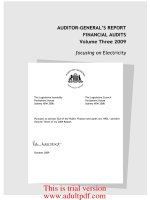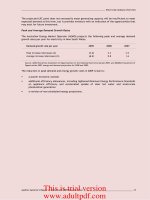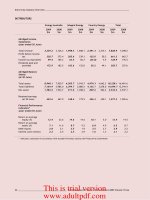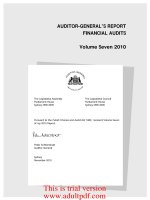New South Wales Auditor-General’s Report Financial Audit Volume Seven 2011 Focusing on Law, Order and Emergency Services_part6 pdf
Bạn đang xem bản rút gọn của tài liệu. Xem và tải ngay bản đầy đủ của tài liệu tại đây (182.24 KB, 10 trang )
49
NSW Auditor-General's Report
Volume Seven 2011
NSW TRUSTEE AND
GUARDIAN
Abridged Statement of Financial Position
At 30 June
2011
$’000
2010
$’000
Current assets
53,780
46,397
Non-current assets
63,535
57,779
Total Assets
117,315
104,176
Current liabilities
21,969
21,810
Non-current liabilities
38,360
37,675
Total Liabilities
60,329
59,485
Net Assets
56,986
44,691
Current assets increased mainly due to an increase in cash and cash equivalents resulting
from:
the receipt of $7.6 million from the Interest Suspense Account
no payments for income tax and dividends in 2010–11 compared to $3.0 million in 2009–
10 (as a for profit entity, the former Public Trustee was liable to pay dividend and income
tax equivalents to Treasury).
Non-current assets increased due to a $2.6 million increase in financial assets and a
$3.6 million increase in the carrying value of property plant and equipment.
Trustee Services Activities
The NSW Trustee and Guardian may act as a trustee; as an executor or administrator; as
collector of estates under an order to collect; as an agent or attorney; as guardian or receiver
of the estate of a minor; and as receiver of any other property.
The Trustee services of the NSW Trustee and Guardian include:
will making
executor services
administration of deceased estates
trustee of trusts created by wills, deeds, court orders and legislation
power of attorney services
management/sale of assets seized or confiscated under the Confiscation of Proceeds of
Crime Act 1989 and the Criminal Assets Recovery Act 1990.
The Chief Executive Officer of the NSW Trustee and Guardian is also the Commissioner of
Dormant Funds under the Dormant Funds Act 1942. This involves investigating and
recommending proposals for dealing with funds acquired by trustees for charitable or other
public purposes, which have become dormant.
Financial Management Activities
The NSW Trustee and Guardian provides the following services:
manages the affairs of those persons who are not able to manage their own affairs and
whose affairs have been formally committed to management by order under the Act
authorises and directs the performance and duties of private managers appointed by the
Supreme Court or the Guardianship Tribunal.
The Chief Executive Officer of the NSW Trustee and Guardian reports administratively to the
Attorney General via the Director General of DAGJ.
This is trial version
www.adultpdf.com
50
NSW Auditor-General's Report
Volume Seven 2011
NSW TRUSTEE AND
GUARDIAN
Public Guardian
The Public Guardian makes personal lifestyle decisions on behalf of adults who have a
decision-making disability. Decisions are made in such areas as accommodation, services
and consenting to medical and dental treatment. The Public Guardian also provides support to
private guardians. The total number of clients managed for 2010–11 financial year was 2,560.
For further information, refer to www.tag.nsw.gov.au (NSW Trustee and Guardian) and
www.lawlink.nsw.gov.au/opg (Office of the Public Guardian).
This is trial version
www.adultpdf.com
51
NSW Auditor-General's Report
Volume Seven 2011
OFFICE OF THE DIRECTOR OF
PUBLIC PROSECUTIONS
Audit Opinion
The audit of the Office of the Director of Public Prosecution’s financial statements for the year
ended 30 June 2011 resulted in an unmodified audit opinion within the Independent Auditor’s
Report.
Operational Snapshot
The Office works to provide an independent and just prosecution service to the people of New
South Wales. It conducts all indictable and some summary prosecutions referred to it by the
NSW Police Force. Its net cost of providing these services was $103 million in 2010–11
($95.8 million in 2009–10).
Key Issues
Motor Vehicle Benefit
In 2009–10, I reviewed the salary entitlements of a selected range of employees. As a result
of that review, the Office has recovered an overpayment of a motor vehicle benefit to a former
employee totalling $202,071. The overpayment and recovery are disputed by the former
employee.
Performance Information
The Office provided the following information regarding its performance.
Number of trials registered and completed at 30 June
2011
2010
2009
2008
2007
Supreme Court
Matters registered
87
71
86
89
93
Matters completed
74
87
82
88
78
District Court
Trials registered
1,712
1,706
1,798
1,744
1,755
Trials completed
1,701
1,818
1,699
1,692
1,637
Local Court
Committals registered
5,877
6,073
6,147
6,066
5,541
Committals completed
5,793
5,965
6,375
5,899
5,758
Office of the Director of Public
Prosecutions
$202,071
overpayment of
motor vehicle
benefit recovered
from former
employee
This is trial version
www.adultpdf.com
52
NSW Auditor-General's Report
Volume Seven 2011
OFFICE OF THE DIRECTOR
OF PUBLIC PROSECUTIONS
Number of matters not finalised at 30 June
2011
2010
2009
2008
2007
Supreme Court
Trials
101
82
96
94
112
Sentences
9
12
5
3
8
Court of Criminal Appeal appeals
177
160
129
164
152
District Court
Trials
1,461
1,543
1,672
1,645
1,741
Sentences
987
894
999
860
798
All grounds appeals
538
529
506
475
513
Severity appeals
993
852
954
881
980
Leniency appeals
5
10
9
14
11
Local Court
Committals
3,257
3,152
3,043
2,971
2,707
Advising
104*
105
101
90
67
Source: Office of the Director of Public Prosecutions (unaudited).
* Figure estimated based on early November 2010 figures as statistics not available.
Completion of matters in all courts declined over the prior year, due in part to an increase in
the average length of time from committal to completion. On average, the matters were
completed in 365 days across the Supreme and District courts compared to 349 days in the
prior year.
Generally, the time taken to complete cases depends on several variables, including the mix
and complexity of cases registered and the time the case is listed. In addition, agreement may
be reached for a longer period for completion of the advice to ensure quality advice is
provided.
Other Information
Workforce Ageing
Last year, I recommended the Office develop strategies to manage its ageing workforce. The
Office faces challenges from the potential loss of a large number of retiring legal
professionals. At 30 June 2011, 22.8 per cent (20.3 per cent) of the Office’s employees were
55 years of age or older and 36.0 per cent (34.5 per cent) were 50 years of age or older. The
potential loss of knowledge and skills arising from retirements is a significant risk for the
Office.
The Office advises it will incorporate this risk into its planning processes with a view to finding
effective solutions.
Annual Leave Balances
The Office has actively managed employees with excessive annual leave balances in recent
years. The number of employees with more than 40 days annual leave decreased to
8.9 per cent (12.3 per cent) of total employees at 30 June 2011.
The Office advises it has initiatives in place to address the issue of excessive annual leave
balances, such as monthly monitoring by the Office’s management committee.
This is trial version
www.adultpdf.com
53
NSW Auditor-General's Report
Volume Seven 2011
OFFICE OF THE DIRECTOR OF
PUBLIC PROSECUTIONS
Flex Leave Balances
Managing excessive flex leave balances continues to be an issue for the Office. The total
accumulated flex leave balance has increased from 13,104 hours at 30 June 2010 to 14,124
hours at 30 June 2011. On average, this represents 21.2 hours per employee at
30 June 2011. The number of employees with flex leave balances in excess of 50 hours at
30 June 2011 was 97 (125).
The large flex leave balances indicate employees are working long hours and do not have the
opportunity to take sufficient flex leave during the year. The Office reviews outstanding flex
leave at each management committee meeting and develops leave plans with the employees
to try and reduce excessive balances.
Financial Information
Abridged Statement of Comprehensive Income
Year ended 30 June
2011
$’000
2010
$’000
Employee related
83,686
80,092
Other expenses
22,449
19,957
Operating Expenses
106,135
100,049
Operating Revenue
3,148
4,216
Gain on disposal of non-current assets
8
43
Net Cost of Services
102,979
95,790
Government contributions
99,265
100,124
Surplus/(Deficit)
(3,714)
4,334
The increase in operating expenses is primarily due to an increase in employee related
expenses, resulting from the four per cent pay rise during the year. In addition, there has been
an increase in rental expenses and expenses for private barristers because of the number of
employees on long service leave and long term sick leave during the year.
Abridged Statement of Financial Position
At 30 June
2011
$’000
2010
$’000
Current assets
6,333
5,596
Non-current assets
14,231
17,099
Total Assets
20,564
22,695
Current liabilities
13,135
11,457
Non-current liabilities
2,305
2,044
Total Liabilities
15,440
13,501
Net Assets
5,124
9,194
The decrease in non-current assets is primarily due to the depreciation charge for the current
year.
This is trial version
www.adultpdf.com
54
NSW Auditor-General's Report
Volume Seven 2011
OFFICE OF THE DIRECTOR
OF PUBLIC PROSECUTIONS
Abridged Service Group Information
The Office’s net cost of services on a service group basis is detailed below:
Year ended 30 June
Net Cost of Services
Net Assets
2011
Budget
$’000
2011
Actual
$’000
2010
Actual
$’000
2011
Actual
$’000
2010
Actual
$’000
Prosecutions
94,769
99,382
92,070
5,274
9,047
Victim and witness Assessment
4,597
3,597
3,720
(150)
147
Total All Service Groups
99,366
102,979
95,790
5,124
9,194
The overall net cost of services has increased by $7.2 million, which is also $3.6 million above
budget. This is primarily due to the increase in employee related expenses and other
expenses as mentioned above.
Office Activities
The Office was constituted under the Director of Public Prosecutions Act 1986. The principal
functions and responsibilities of the Director of Public Prosecutions are to institute and
conduct, on behalf of the State, prosecutions for indictable offences in the District and
Supreme Courts and to appear as appellant or respondent in criminal appeals.
For further information on the Office, refer to www.odpp.nsw.gov.au.
This is trial version
www.adultpdf.com
55
NSW Auditor-General's Report
Volume Seven 2011
NSW POLICE FORCE
Audit Opinion
The audit of the NSW Police Force’s financial statements for the year ended 30 June 2011
resulted in an unmodified audit opinion within the Independent Auditor’s Report.
Operational Snapshot
The Force incurred net costs of $2.87 billion in 2010–11 to provide its services, which include:
community support – responding to incidents, emergencies and public events and
reducing incentives and opportunities to commit crime, net cost $1.5 billion
criminal investigation – crime detection, investigation, provision of forensic services and
arresting, net cost $831 million
traffic and commuter services – patrolling roads, highways and public transport corridors,
investigating major vehicle crashes, detecting traffic and transport offences and
supervising peak traffic flows, net cost $330 million
judicial support – judicial and custodial services, prosecuting offenders, presenting
evidence at court, support to victims and witnesses and providing transport and custodies
for person under police supervision, net cost $200 million.
Key Issues
Death and Disability Scheme (Repeat Issue)
Recommendation
I again recommend the Force review the underlying causes for the increasing number of
partial and permanent claims and urgently develop and implement strategies to address the
unfavourable trend.
The Force should continue to closely monitor its liquidity to ensure it has sufficient funds to
meet the increasing costs of the scheme. The lump sum payment structure should be
reviewed and alternative forms of payment be considered.
The Force should provide appropriate rehabilitation to injured officers to help ensure their
return to the workforce and to meet its continuing obligation to support them after partial and
permanent disability payments have been made.
The Force’s liability for the death and disability scheme is based on an independent actuarial
assessment. The death and disability liability has grown significantly by $169 million or
147 per cent since 2007–08 and by 49 per cent in 2010–11. The partial and permanent
incapacity (PPI) claims paid, a component of the death and disability scheme, has increased
by 47 per cent to 415 claims in 2010–11. Of the total PPI claims paid in 2010–11, 79 per cent
related to psychological claims and 95 per cent had a psychological component to the injury.
NSW Police Force
Partial and
permanent
disability liabilities
and payments
continued to trend
upwards
Death and
disability liabilities
increased by
49 per cent in
2010–11
This is trial version
www.adultpdf.com
56
NSW Auditor-General's Report
Volume Seven 2011
NSW POLICE FORCE
The increase in the number of claims is undesirable, not only from a financial perspective, but
also from the impacts on the Force more generally.
Year Ended 30 June
2011
2010
2009
2008
Death and disability liability ($’000)
284,000
190,200
147,300
115,000
Total partial and permanent incapacity claim
payments ($’000)
165,010
118,992
47,053
40,930
Number of partial and permanent incapacity claims
paid
415
282
116
108
Average claim size ($)
458,000
421,958
405,626
378,986
Source: Liability figures obtained from actuarial reports (audited). Remaining information obtained from NSW Police Force (unaudited).
The Force introduced an independent medical expert panel (the panel) in February 2010 to
manage this unfavourable trend. The panel:
conducts independent assessments of an officer’s capacity to work (subject to Work
Cover Guidelines)
conducts independent assessments of diagnosis and treatment (subject to Work Cover
Guidelines)
helps develop and endorse return to work plans
develops strategies for upgrading injured officers to some form of capacity to work.
Since the panel was introduced, 187 referrals have been assessed and of that number only
one officer had their top-up payment terminated and on subsequent appeal this decision was
overturned. Evidence suggests the independent panel doctors rely heavily on the opinion of
the injured officer and their treating doctor. To date, the panel has had no impact on the
unfavourable increase in claims.
On 3 November 2011, the Minister for Police announced that the current death and disability
scheme will be replaced with a new commercial insurance arrangement.
I will continue to monitor the overall liability of the scheme and the outcomes of the intended
actions.
In 2008, I conducted a performance audit on managing injured police. The Force advises it
has implemented most of my recommendations. A full copy of this report can be found at:
www.audit.nsw.gov.au/publications/reports/performance/performance_reports.htm.
Allocation of Police Officers
There is a shortfall between actual full time equivalent (FTE) police officers and authorised
positions in all regions. At 30 June 2011, the Force had 12,181 FTE police officers compared
with 12,378 authorised positions, a shortfall of 197. This is an improvement on last year’s
shortfall of 489. Of the 12,181 FTE officers, 1,680 (1,833) were on restricted duties or absent,
which means the actual shortfall is greater. A restricted officer is still available for operational
work, but their work tasks are restricted to meet their individual circumstances.
Actions taken to
address the
unfavourable
trend in claims
have had no
impact to date
Shortfall between
actual police
officers and
authorised
positions has
improved
This is trial version
www.adultpdf.com
57
NSW Auditor-General's Report
Volume Seven 2011
NSW POLICE FORCE
The Force advises that it continues to monitor the number of available police officers on a
weekly basis and builds this information into its assessment of the number of officers it should
recruit.
30 June 2011
Region*
Authorised
FTE
Actual
FTE
Difference between
authorised and
actual
FTE
Total on restricted
duties or absent
FTE
Central Metropolitan
2,681
2,581
(100)
261
North West Metropolitan
2,375
2,349
(26)
291
Northern
2,163
2,158
(5)
404
South West Metropolitan
2,351
2,302
(49)
284
Southern
1,616
1,613
(3)
252
Western
1,192
1,178
(14)
188
Total
12,378
12,181
(197)
1,680
Total 30 June 2010
12,337
11,848
(489)
1,833
Source: NSW Police Force (unaudited)
* Includes police officers attached to Regions and Local Area Command and excludes officers who are part of
Specialist Operations and Other Non Region Commands.
FTE Full-time Equivalent
Performance Information
Statistics on rates of crime, crime investigations and crime rejection have been included in the
Law and Order Overview, located earlier in this volume.
Other Information
Recoupment of Workers Compensation Claims (Repeat Issue)
Recommendation
I again recommend the Force reviews processing of its workers compensation claims to
minimise delays in recouping claims from the insurer.
The Force continues to experience delays in settling workers compensation claims with its
insurer. At 30 June 2011, the Force was owed $4.0 million ($4.3 million) for claims lodged
before 31 December 2010. The Force advises the main reasons for delays are data matching
issues and staff shortages.
In 2011, the Force created a specialised employee compensation claims unit and redrafted
standard operating procedures to help eliminate the delays being experienced. I will continue
to monitor the intended benefits of these changes.
Death and Disability Payments
The Crown Employees (Police Officers Death and Disability) Award 2005 (the award) states
an employee may receive only one benefit, either a partial and permanent disability (PPD)
benefit or a total and permanent disablement (TPD) benefit. Some employees received a PPD
payment, but subsequently became eligible for a TPD payment. These employees are
required to return the PPD benefit to the Force, and I noted some instances where the Force
had difficulties recovering these amounts in a timely manner.
In 2010-11, 36 officers were overpaid a total of $15.2 million of which $13.3 million was
recovered. At 30 June 2011, terminated employees owed the Force $2.7 million, of which
$2.1 million was determined to be difficult to recover and was impaired.
This is trial version
www.adultpdf.com
58
NSW Auditor-General's Report
Volume Seven 2011
NSW POLICE FORCE
To reduce duplicate payments, the award has been amended so employees are only entitled
to receive the difference between the PPD and TPD amount. This, however, requires the
authority of all parties, limiting its applicability to officers who:
have previously signed the authority, or
are willing to sign the deed and authority for First State Super to deduct the PPD amount
owing to the Force from the TPD payment.
The Force advises it is in the process of sending each officer who has received a PPD
payment a letter asking them to sign and return an authority to deduct form. Officers who have
applied for a PPD claim are now required to complete a deed and authority form before a PPD
claim will be paid by the Force.
Property Management
Management of the Force’s property has been outsourced to a private sector entity as a result
of a government directive. The State Property Authority (SPA) acts as the contract
administrator and is responsible for compliance and the delivery of services. SPA’s duties
include formally directing the company providing the services, certifying work performed and
recommending payment.
An internal audit review in 2009–10 confirmed existing controls and processes could be
improved. The review also found:
the strategic direction in property maintenance was lacking
maintenance was reactionary
key performance indicators (KPIs), as set out in the contract, were not measured
appropriately.
Last year, I recommended the Force allocate appropriate resources to implement internal
audit recommendations to minimise the potential for fraud/ misappropriation of funds and to
maximise the effectiveness of its maintenance spend. Management advises the
recommendations were implemented in February 2011 and reviews are being conducted
quarterly. The Force is assessing the effectiveness of the agreed actions and is holding
ongoing discussions with SPA, the Police Property Group, the service provider and internal
audit. I will continue to monitor progress of the agreed actions.
I also recommended the Force amend deficiencies in the contract, which did not allow it to
audit or inspect the service provider’s transactions. The Force advises the contract was
extended in July 2011 and it now requires the service provider to report against 11 KPIs
designed to allow it to effectively manage performance issues. The first quarterly KPI report
has been submitted and the Force is planning a formal review.
Human Resources
I reviewed the actions taken by the Force to address recommendations I made last year
relating to human resource issues.
Annual Leave (Repeat Issue)
Managing excessive annual leave balances remains a challenge for the Force. While it is
actively managing this issue, a high number of officers still have excessive leave balances at
30 June 2011. Over four thousand sworn officers had accrued more than 342 hours of annual
leave and over four hundred unsworn officers had accrued more than 280 hours of annual
leave.
Year ended 30 June
2010–11
2009–10
2008–09
Sworn officers with accumulated leave >342 hrs
4,183
4,149
4,861
Unsworn officers with accumulated leave >280 hrs
429
484
576
Total
4,612
4,633
5,437
This is trial version
www.adultpdf.com









